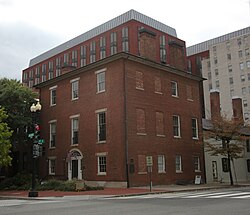Decatur House
|
Decatur House
|
|

North side of Decatur House as restored 2006–2008.
|
|
| Location | 748 Jackson Pl., NW. Washington, D.C. |
|---|---|
| Coordinates | 38°53′58.94″N 77°2′20.03″W / 38.8997056°N 77.0388972°WCoordinates: 38°53′58.94″N 77°2′20.03″W / 38.8997056°N 77.0388972°W |
| Area | < 1-acre (0.40 ha) |
| Built | 1818 |
| Architect | Benjamin Henry Latrobe |
| Architectural style | Federal |
| Part of | Lafayette Square Historic District (#70000833) |
| NRHP Reference # | 66000858 |
| Significant dates | |
| Added to NRHP | October 15, 1966 |
| Designated NHL | December 19, 1960 |
| Designated NHLDCP | August 29, 1970 |
Decatur House is a historic house museum at 748 Jackson Place in Washington, D.C., the capital of the United States. It is named after its first owner and occupant Stephen Decatur. The house (built, 1818) is located at the northwest corner of Lafayette Square, at the southwest corner of Jackson Place and H Street, near the White House. A museum, it now serves as the National Center for White House History, managed by the White House Historical Association.
Decatur House is one of the oldest surviving homes in Washington, D.C., and one of only three remaining houses in the country designed by neoclassical architect Benjamin Henry Latrobe. Completed in 1818 for naval hero Stephen Decatur and his wife, Susan, the Federal Style house is prominently located across Lafayette Square from the White House. It was successively home to Henry Clay, Martin Van Buren and Edward Livingston, who collectively made Decatur House the unofficial residence of the Secretary of State from 1827 to 1833, each renting the house while they served in that post.
In 1836 John Gadsby and his wife Providence moved into the house and brought their house slaves. They built a two-story structure at the back which became the slave quarters for those workers, who previously lived in the main house. This structure remains as one of the few examples of slave quarters in urban areas. It is physical evidence of African Americans having been held "in bondage in sight of the White House."
...
Wikipedia



